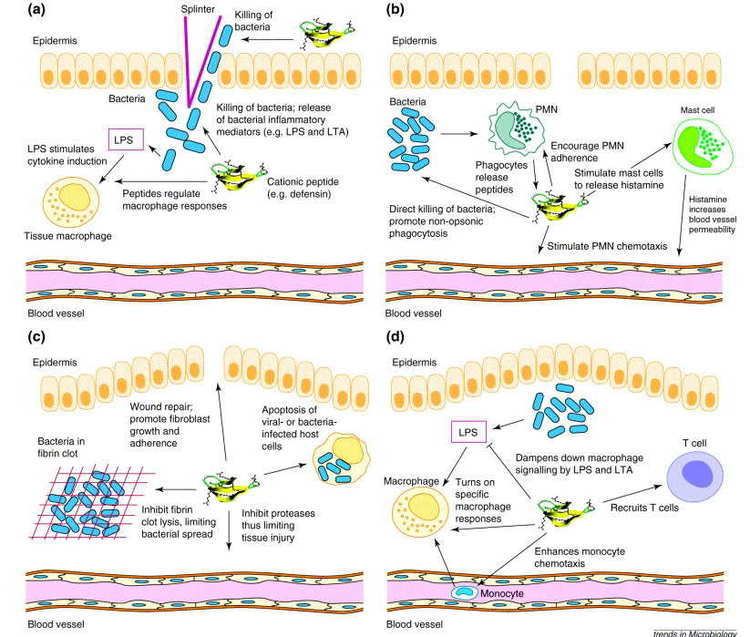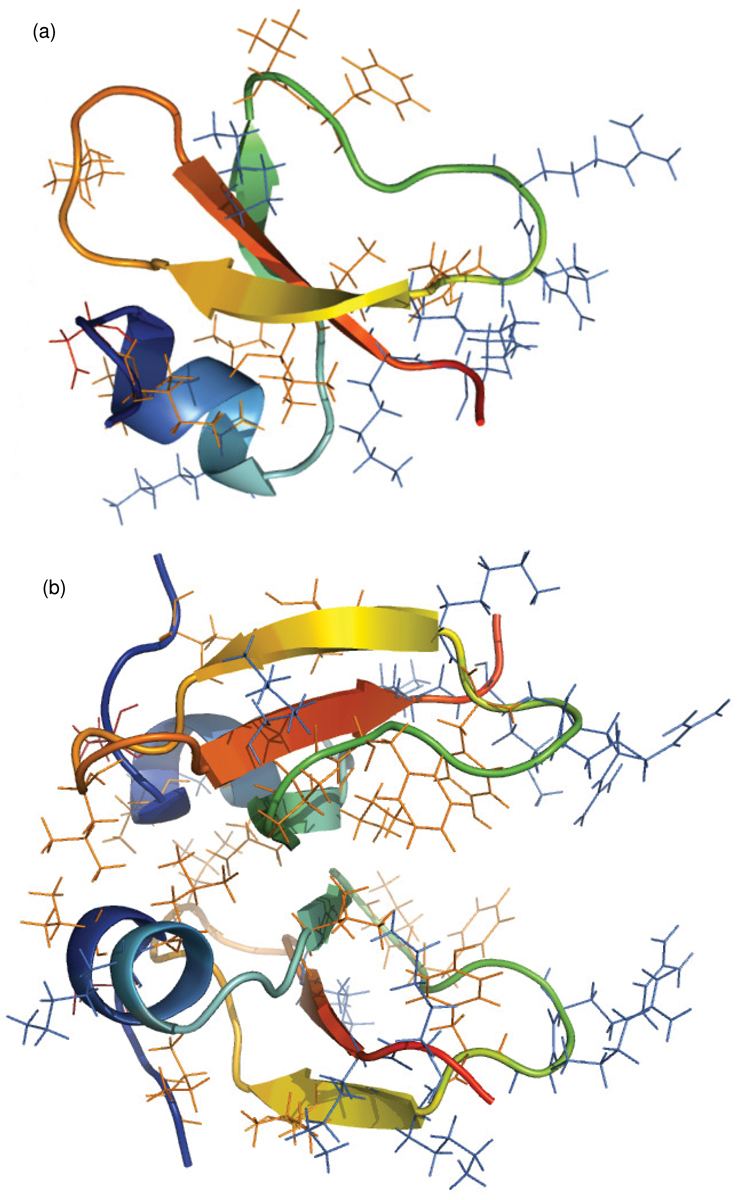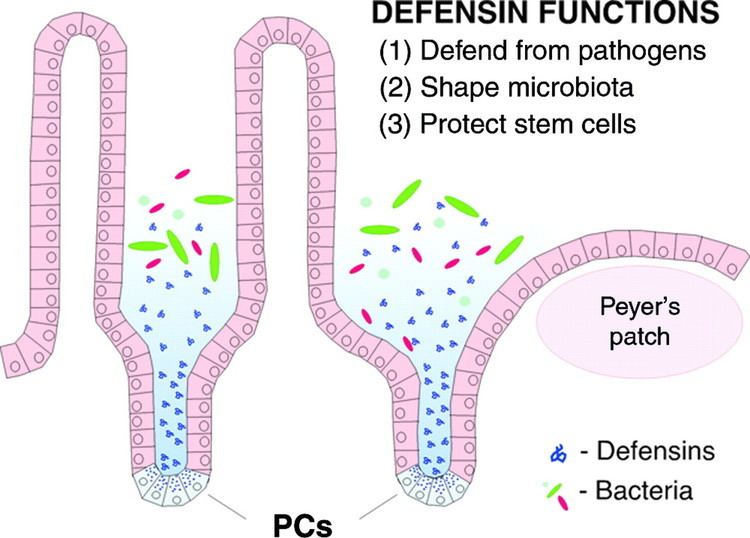 | ||
Immunology complement opsonization inflammation and defensins
Defensins are small cysteine-rich cationic proteins found in both vertebrates and invertebrates. They have also been reported in plants. They are, and function as, host defense peptides. They are active against bacteria, fungi and many enveloped and nonenveloped viruses. They consist of 18-45 amino acids including six (in vertebrates) to eight conserved cysteine residues. Cells of the immune system contain these peptides to assist in killing phagocytosed bacteria, for example in neutrophil granulocytes and almost all epithelial cells. Most defensins function by binding to the microbial cell membrane, and, once embedded, forming pore-like membrane defects that allow efflux of essential ions and nutrients.
Contents
- Immunology complement opsonization inflammation and defensins
- Dr ed hollox defensins research university of leicester
- Varieties
- Function
- Pathology
- Defensin mimetics as antibiotics antifungals and anti inflammatories
- References

Defensins are antimicrobial peptides that act mainly by disrupting the structure of bacterial cell membranes and are found in many compartments of the body. Evidence is accumulating that defensins play a central role in defense against pathogens, and they are considered as a part of the innate immune response. They have generally been considered to contribute to mucosal health; however, it is possible that these peptides can be considered biological factors that can be upregulated by bioactive compounds presents in human breast milk. In this sense, the intestinal production of antimicrobial peptides as hBD2 and hBD4 by trefoil from milk might play an important role on neonate colonization, thereby enhancing the immune response of newborn against pathogens with which they may come in contact.

Dr ed hollox defensins research university of leicester
Varieties

The name 'defensin' was coined in the mid1980s, though the proteins had been studied as 'Cationic Antimicrobial Proteins'. The underlying genes responsible for defensin production are highly polymorphic. Some aspects are conserved, however; the hallmarks of a β-defensin are its small size, high density of cationic charge, and six-cysteine-residue motif. In general, they are encoded by two-exon genes, wherein the first exon encodes for a hydrophobic leader sequence and the second for a peptide containing the cysteine motif. All defensins have disulfide linkages. The disulfide linkages have been suggested to be essential for activities related to innate immunity in mammals, but are not necessarily required for antimicrobial activity.

The mammalian defensins (Table below) are different from arthropod defensins. The latter are more similar to protein scorpion toxins. Subsequent investigations confirmed relationships between scorpion toxins that block potassium channels and insect defensins in their three-dimensional structure and their disruption of membrane functions of invasive microbes. Experimental deletion of a small loop of a defensin molecule from a Hymenopteran parasitoid venom that shares attributes of scorpion toxin, removed steric hindrance of interactions between peptides and channels. The resulting peptide was neurotoxin that selectively inhibited potassium channels, binding to the channels in the same manner as scorpion toxins. The results presented structural and functional evidence for the basis of toxin evolution.

Theta defensins form a single beta hairpin structure and therefore also represent a distinct group. Only alpha and beta defensins are expressed in humans.
Function
In immature marsupials, because their immune system is underdeveloped at the time of birth, defensins play a major role in defense against pathogens. They are produced in the milk of the mother as well as by the young marsupial in question.
In human breast milk, defensin play a central role in neonate immunity.
Human genome contains theta-defensin genes, but they have a premature stop codon, hampering their expression. An artificial human theta-defensin, retrocyclin, was created by `fixing' the pseudogene, and it was shown to be effective against HIV and other viruses, including herpes simplex virus and influenza A. They act primarily by preventing these viruses from entering their target cells.
Also interesting is the effect of alpha-defensins on the exotoxin produced by anthrax (Bacillus anthracis). Chun Kim et al. showed how anthrax, which produces a metalloprotease Lethal Factor (LF) protein to target MAPKK, is vulnerable to human neutrophil protein-1 (HNP-1). This group showed HNP-1 to behave as a reversible noncompetitive inhibitor of LF.
Defensin-like proteins are also a component of platypus venom.
Pathology
The alpha defensin peptides are increased in chronic inflammatory conditions.
Alpha defensin are increased in several cancers, including colorectal cancer.
An imbalance of defensins in the skin may contribute to acne.
A reduction of ileal defensins may predispose to Crohn's disease.
In one small study, a significant increase in alpha defensin levels was detected in T cell lysates of schizophrenia patients; in discordant twin pairs, unaffected twins also had an increase, although not as high as that of their ill siblings. The authors suggested that alpha-defensin levels might prove a useful marker for schizophrenia risk.
Defensins are found in the human skin during inflammatory conditions like psoriasis and also during wound healing.
Defensin-mimetics as antibiotics, antifungals, and anti-inflammatories
Defensin mimetics, also called host defense peptide (HDP) mimetics, developed at the University of Pennsylvania, are completely synthetic, non-peptide, small molecule structures that mimic defensins in structure and activity. Similar molecules, such as brilacidin, are being developed as antibiotics, anti-inflammatories for oral mucositis, and antifungals, especially for candidiasis.
